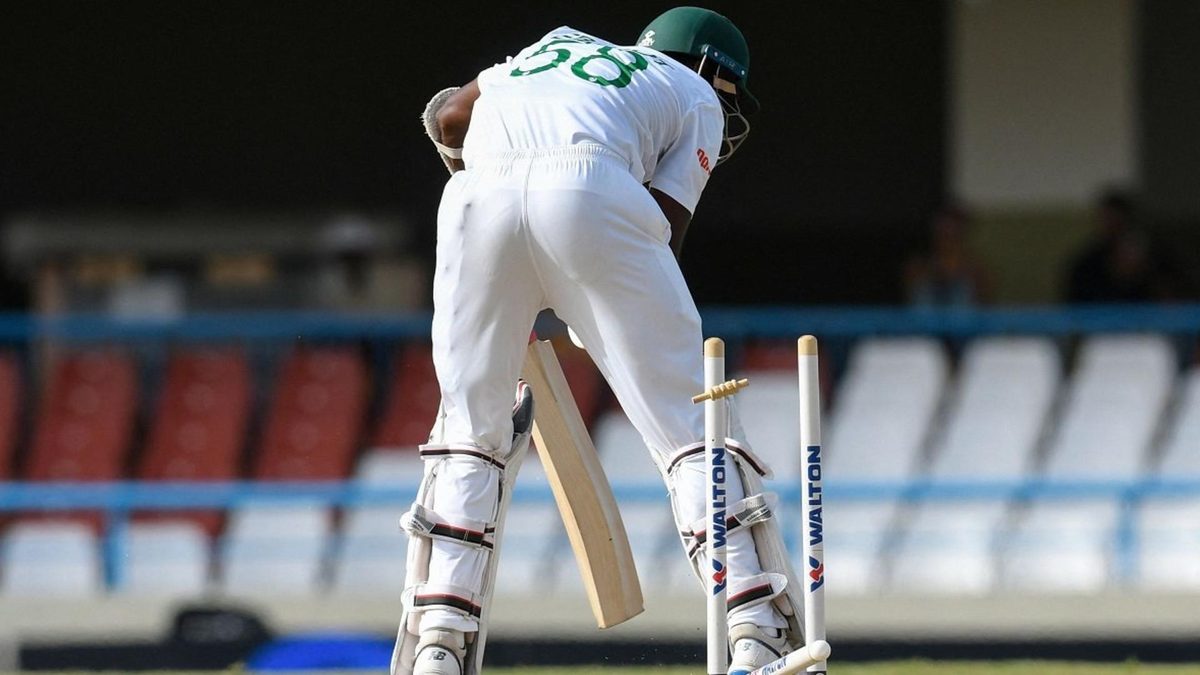
The last four in the Bangladesh Test XI form one of the most remarkable tails in recent past, and is an excellent throwback to older days of cricket.
For Bangladesh, only Shakib Al Hasan has more Test wickets than Taijul Islam. While there is little doubt over Taijul’s bowling credentials, he has, at the time of writing, 537 runs at an average of 8.95.
At positions eight or lower – he has been used as a nightwatch a few times – that number reads 9.44, across 65 innings. In 146 years of Test cricket, only 13 cricketers have batted as many times in the bottom four and have a lower batting average.
Most of these 13 have, at some point of in their careers, caused some hilarity with their batting skills. Chris Martin, Bhagwat Chandrasekhar, Shannon Gabriel, Monty Panesar, Glenn McGrath, Courtney Walsh, Danish Kaneria…you probably get the idea.
Taijul belongs to that league of batters, but he bats at eight for Bangladesh. The obvious conclusion is that there are three batters in the XI who are worse than that league.
In fact, that is indeed the case. Shoriful Islam, the Bangladesh No.9, averages 5.91 in first-class cricket; No.10 Ebadot Hossain 3.34; and No.11 Khaled Ahmed 4.71 – all worse than Taijul’s Test average.
The batting career of this trinity makes remarkable reading. Shoriful, for example, has 42 runs from nine innings till date in Test cricket – but that includes a 17-ball 26 against the West Indies at Gros Islet. We shall return to this innings.
Ebadot’s 31 innings have amounted to 50 runs, but that hardly tells the full story. After 26 innings, his aggregate stood at 12 – in other words, he scored fewer than a run every two appearances at the crease.
Then it all changed with a 21 not out – against the West Indies at Gros Islet.
Imagine the plight of the West Indian bowlers who had reduced Bangladesh to 191-8, only to be ambushed by two of the most inept batters Test cricket has seen. While Shoriful biffed his way to glory, Ebadot anchored the partnership during his 35-ball stay.
Naturally, he was promoted to No.9 in the second innings, while Shoriful batted at ten. Both failed to score this time, and all was well with the world, more so because Khaled failed to score as well.
When India arrived, Bangladesh played only two seamers, and Ebadot returned to No.10. This time he made 17 – his second two-digit score in three innings – but he was still not promoted ahead of Taijul in the second innings. Ebadot made a duck again.
Khaled, of course, failed to score in the entire Test match. His case is entirely different, for he started as a No.10, above Ebadot. He made an unbeaten four in his second innings – Bradmanesque, given the context – but failed to score in each of his next 11 innings.
By the time that run ended, Ebadot had usurped him from that No.10 slot. This was no ordinary promotion, for it involved a world record. Khaled’s 11 scoreless innings is the longest streak in the history of Test cricket. He broke the previous record of 10, by… Ebadot.
The matter runs deeper than this, for Khaled had a separate streak of four, while Ebadot has two streaks – of six and four. The length of Ebadot’s career has enabled him to get more streaks of four or more, but Khaled’s streak is the longest in the world.
If scoreless streaks were Test hundreds, Ebadot would have been Sachin Tendulkar and Khaled Brian Lara.
The Bangladesh tail is reminiscent of their counterparts in several Test XIs from not too long ago.
During the Kerry Packer era, Australia were forced to go in with depleted XIs. Twice in the 1978/79 Ashes did their tail read Rodney Hogg, Geoff Dymock, Alan Hurst, and Jim Higgs – all of whom averaged under 10 in Test cricket. Against New Zealand at The Oval in 1999, England’s No.8 was Andy Caddick, whose most frequent batting position was No.10, and highest score came from No.11.
Caddick batted at that position because he had to bat above Alan Mullally, Phil Tufnell, and Ed Giddins. This came six years after England had gone in with Angus Fraser, Steve Watkin, Peter Such, and Devon Malcolm.
Curtly Ambrose batted at No.8 in the Wellington Test match of 1994/95. If Ambrose’s average of 12.40 diluted this list, the last three – Courtney Walsh, Kenny Benjamin, Rajindra Dhanraj – made it memorable.
When India decided to go with an all-pace attack for the Perth Test match of 2017/18, their last four were Umesh Yadav, Ishant Sharma, Mohammed Shami, and Jasprit Bumrah. Umesh was not there for Lord’s and Headingley 2021, but he was replaced by Mohammed Siraj, even more inept with the bat.
Even more recently, in the Christchurch classic from earlier this year, Sri Lanka’s bottom four were Kasun Rajitha, Prabath Jayasuriya, Lahiru Kumara, and Asitha Fernando. Of them, only Jayasuriya has a double-digit first-class average. Each of them registered their respective highest scores that day: 22, 13, 13 not out and 10. It must rank among the greatest performances by a tail.
The list is long, but in almost every instance, the tail was a stopgap arrangement. If Bangladesh play three seamers, Taijul, Shoriful, Ebadot, and Khaled seem set for several Test matches together unless Taskin Ahmed returns to the side with his colossal average of 12.17.








